Some clocks run faster than others. With Harley-Davidson nearly a decade into iterations of the Milwaukee-Eight V-twin engine, here's Indian Motorcycles, a mere five years from the launch of the Challenger, pushing the PowerPlus engine into more models.
Indian recognizes that not all riders want a modern-looking, nearly un-finned engine between their heels, so you can still get a Chieftain with the air-cooled Thunderstroke that's styled to look like a flathead. But the future is undoubtedly with the liquid-cooled PowerPlus engine. Indian revealed its intentions in January, as Dustin Wheeler has reported, by offering its fork-mounted-fairing models with the PowerPlus engine. Less than a month after that, a huge pile of journalists gathered outside of Las Vegas to ride the newest engine in a revitalized Chieftain.
First, a quick recap. Fans of the cylinder fin will be happy to know the Thunderstroke engines remain with the standard Springfield, Chieftain, and Roadmaster forms. (Harley-centric thinkers can imagine the Road King, Street Glide, and Electra Glide, respectively.) It would be pretty easy to think of the PowerPlus versions — Chieftain PowerPlus and Roadmaster PowerPlus — as the same old motorcycles with the liquid-cooled engine replacing the styled-like-a-flathead Thunderstroke.
Except they're not.
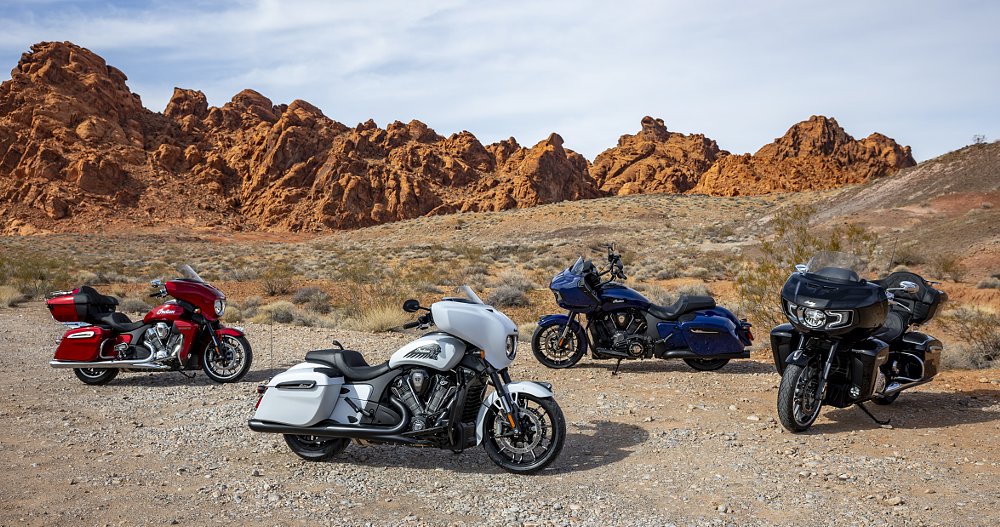
In fact, the new models leverage off the Challenger and Pursuit platform, which has a frame-mounted fairing, while the Chieftain and Roadmaster retain a fork-mounted "batwing" fairing that's been significantly restyled from the previous Chieftain. More importantly, the old Thunderstroke Chieftain’s steel-tube frame has been replaced by the Challenger's cast-aluminum piece. All of the key dimensions are the same but the new chassis receives a host of updates, including an inverted fork, new single-shock rear suspension with remote hydraulic preload (in place of an air spring previously), and uprated Brembo brakes managed by a six-axis IMU for lean-angle-sensitive ABS and linked braking. The six-gallon fuel tank is slightly larger than before.
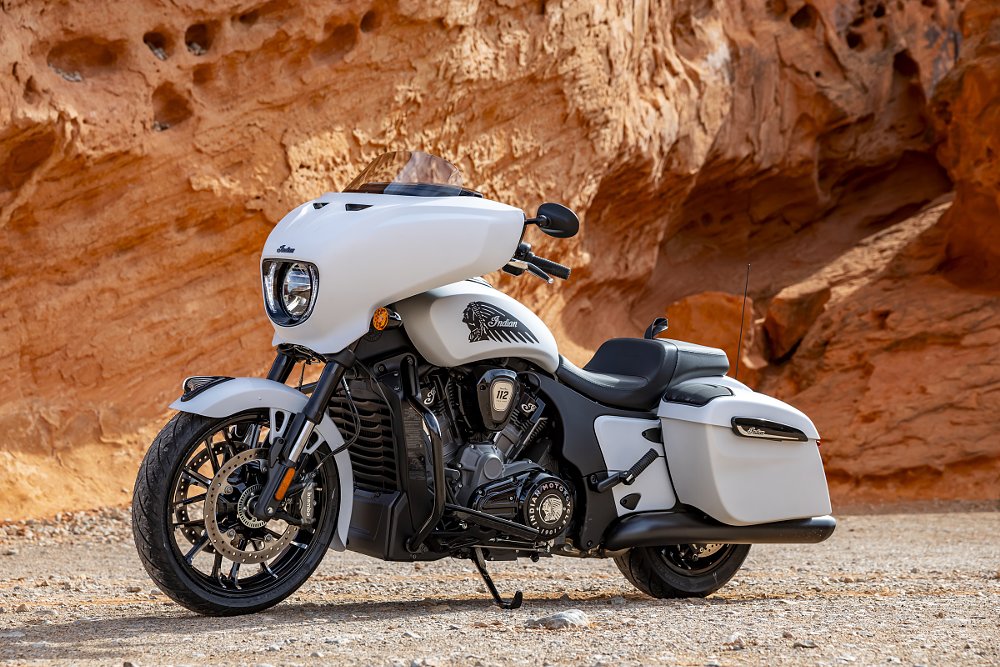
It's really about the engine
That's all fine, but the emphasis here is on the PowerPlus engine. For this year, two versions of the PowerPlus are available, in 108- and 112-cubic-inch iterations. All but the two base models can be had with the 112 and all we rode at the intro were the bigger-engined variants. While no doubt there are myriad differences inside, Indian says only that the bigger engine has a two-millimeter-larger bore (110 mm instead of 108 mm) and a marginally greater compression ratio (11.4:1 versus 11.0:1) to net an increase of four horsepower and five foot-pounds of torque. It's a slightly oversquare engine with a 1.4:1 bore-to-stroke ratio and a 6,500 rpm redline. Each head has a single cam and four valves.
If you accept that the engine is the heartbeat of a motorcycle, you can understand how the PowerPlus may surprise traditional-minded riders. Full disclosure here: Because I don't swim in the pool of press bikes the way I used to, this was my first exposure to the PowerPlus engine, though I have plenty of seat time with the Thunderstroke and various versions of the Milwaukee-Eight. Plus Harleys going back to the early Evolution engines.
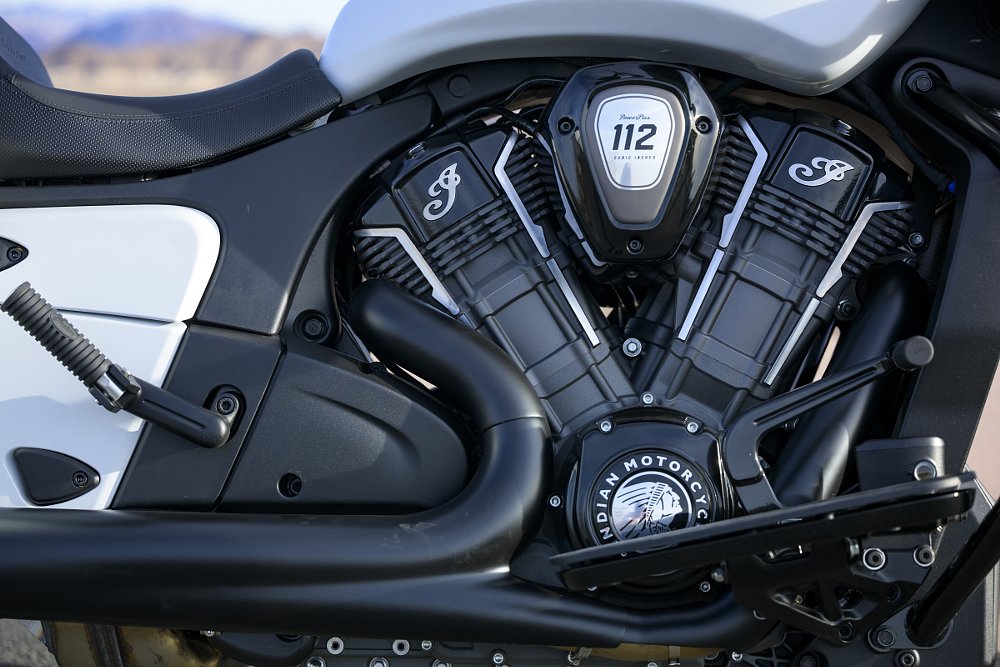
Put simply, the PowerPlus isn't like them. Yes, it's big — you’re not going to disguise 1,834 cc so easily, even if it's slightly less than the Thunderstroke's 1,890 cc — and it comes to life with the expected metallic clack of the starter, quickly settling into the expected chuffing rumble of a big V-twin.
But, really, that's where the similarities end. First of all, this engine has 60 degrees between the cylinders, so it has neither the Harley's syncopated lope nor the steady thrum of a Ducati. It's different and pleasing in its own way, with vibration levels very much subdued but also without that punch-punch-punch feeling of the power pulses you'd get in a traditional Harley. It feels, more than anything else, sophisticated. Quiet and eager.
Indian makes a big deal about the PowerPlus' max power — 126 horsepower and 133 foot-pounds of torque at 3,600 rpm. That's up in torque from the Thunderstroke but what Indian was most proud of is the power curves compared to a current Milwaukee-Eight, which makes strong torque very low in the rev range but runs out of breath quickly. According to the charts, the PowerPlus rides a long-plateauing torque curve to within 1,000 rpm of the 6,500-rpm redline and then falls gradually until the electronics call it quits. At 5,500 rpm, the Harley's redline (where it makes about 70 foot-pounds), the PowerPlus is still putting down 120 foot-pounds with a bit more than 100 foot-pounds still available at the redline.
It feels that way from the saddle, too. Pulling out of the parking lot for the launch ride, I wondered briefly if I hadn't selected second instead of first gear. Truth is, the gearing is actually just right for these models, but the throttle response and amount of available torque right in the basement doesn't follow the standard big-inch cruiser rules.
Some of this sensation comes from the twin-inlet throttle-by-wire system, which is really soft and overly progressive in the Standard mode. Switch to Sport mode and the Chieftain PowerPlus really wakes up. I wish I hadn't spent the first 30 miles or so on the Standard mode.
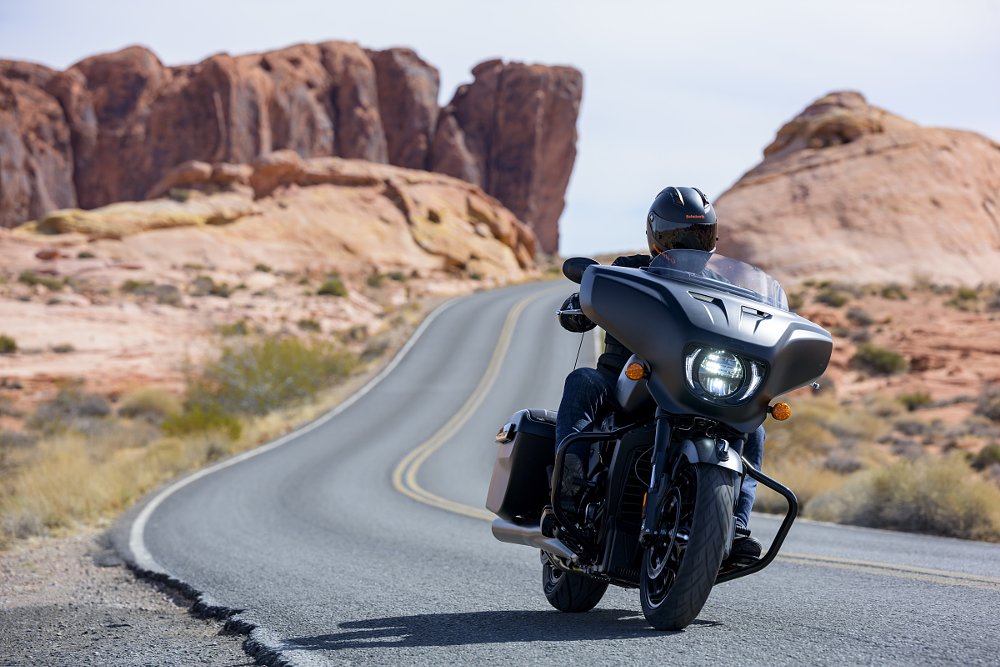
Even so, the PowerPlus is not an engine you'll find yourself lugging around and short-shifting at 2,500 rpm. It's just not that kind of engine, seeing as it's perfectly happy to use all of the rev range. You do sense the early torque peak, but the fact that it doesn't fall on its face early gives you options. Let it rev and you can stretch gears much further than you think you should. Acceleration does slacken near the redline, so it's not so useful to bang off shifts just before the rev limiter, but it's not like venturing to the top end of the tach produces more noise than motivation. I found myself using a gear or two lower than I might otherwise have and enjoying the midrange grunt. Keep the needle between 3,000 and 4,000 rpm and you have a satisfying amount of thrust available.
In every way, the PowerPlus acts like a modern engine. In the Sport mode, throttle response is very good and deliciously predictable; it doesn't feel like the engine has half a ton of flywheel but it also doesn't feel skittish. It does what you want it to do, and vigorously at that.
It wasn't warm during our ride, but there was little evidence of heat issues for the rider. A large radiator up front takes care of that and cylinder deactivation allows the rear cylinder to take some time off when the bike is stopped in traffic.
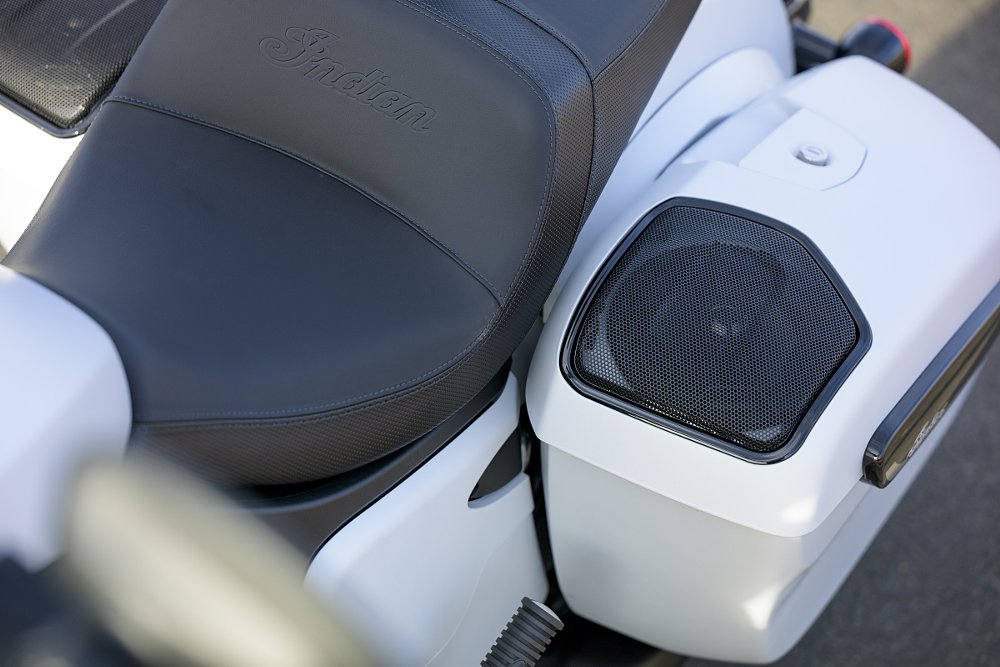
What you do notice is a slightly unusual vibration signature at highway speeds. It's not the fizzy sense you get from a rigid-mounted Harley, nor is it the floating-in-molasses sensation from some of the rubber-mounted engines. It's somewhere in the middle, a very mild mid-frequency hum through the six-gallon tank and handgrips that's not the last bit annoying, just different. I suspect after more than a day in the saddle, I'd hardly notice it.
Most of my day with the Indian crew was spent on the Chieftain PowerPlus, with a little time later in the day on a Challenger and a very brief stint on the Roadmaster PowerPlus. Beyond the sense of the engine being modern, quiet, and powerful, the prevailing impressions are that the chassis work has paid off. Generally, the Chieftain, whose steering head is burdened with the weight of the fairing, steers well and predictably. Like Harley touring models, it has a steep 25-degree steering-head angle but lots of trail and a long wheelbase, so nothing happens especially quickly. But steering effort is low to moderate, depending on speed, with very few of those hip-shake moments you get on some big touring cruisers.
More credit goes to the uprated suspension, which has reasonable travel — 5.1 inches up front and 4.5 out back — so that the wheels have a bit of stroke to work with in absorbing pavement seams and frost heaves. You do feel it move slightly in the stroke and I only twice got the bike to bottom. But the sense was almost more audible (a definite clank) than physical.
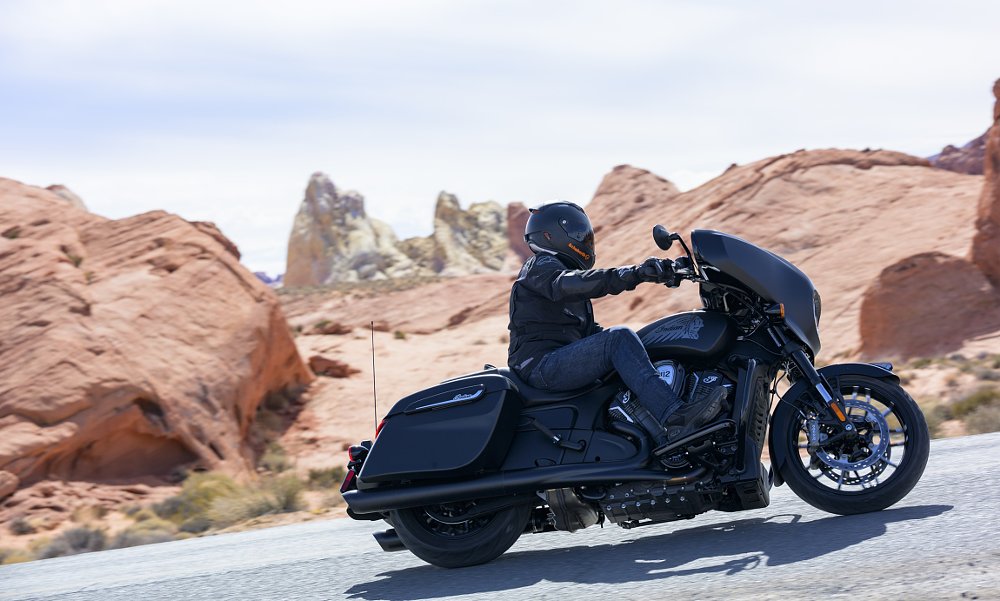
Indian has also given the Chieftain reasonable cornering clearance, so you're less likely to be leaving bits of the generously sized floorboards behind as souvenirs for hikers and bikers. The Chieftain was happy to use the available lean angle without changes in steering feel or a tendency to stand up, even on the brakes.
Truth is, touring riders care more about comfort than cornering, usually, and here the Chieftain is as expected. Most riders appreciate that the more compact and visually appealing "bat-wing" fairing is an aerodynamic compromise. Manufacturers, Harley especially, have been tweaking this basic design for decades to make it work at today's elevated highway speeds. Indian's efforts are generally good here, though I did get a significant amount of head-toss above 65 mph with the Chieftain's low windshield in the low position. For perspective, I'm five feet, nine inches tall with a 32-inch inseam, so my torso is a bit on the short side.
Raising the screen, electrically of course, reveals a slot gap in the base of the screen and gave me relief until about 80 mph. (Hey, we were in Nevada, famous for legal gambling and a general disregard for posted limits.) Above that, the turbulence was so pronounced that I don't think I'd want to stay above 80 for long. Also remember that, stock, the Chieftain runs without lower fairings — just the crash guard, thanks — so there's wind coming at you from every direction.
Otherwise, the Chieftain's ergonomic profile is a winner, with those big floorboards and forward-set controls — a tiny bit too far forward for my tastes, but I'm not tall — and a reasonable reach to the handlebar. For the time I spent between photo stops, the saddle felt fine, but I can't say I did more than about 70 miles at a stretch. Let's call that one TBD.
A taste of other PowerPlus options
Later in the day, on the Roadmaster — with a top trunk, fairing lowers, and a taller windscreen, but otherwise mechanically similar to the Chieftain — I found aerodynamic improvement. The taller screen helps here, as do the lowers. It's not quite as energetic, but that's to be expected: At 933 pounds "in running order," according to Indian, the Roadmaster is almost 100 pounds heavier than the Chieftain. Enough of that is above the beltline to take the edge off the handling.
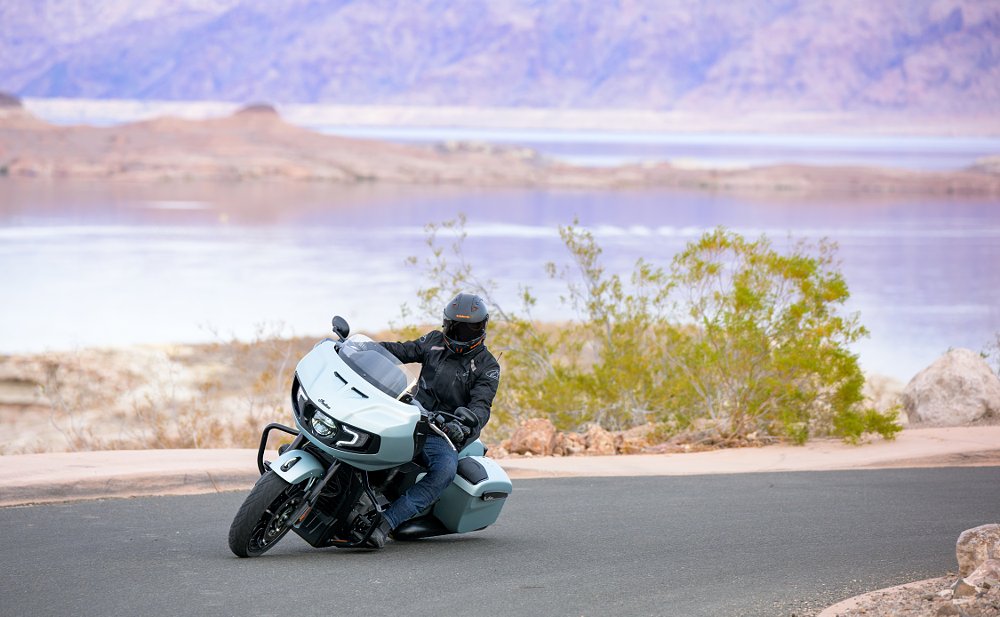
But if you want the better all-out tourer, that's probably the Challenger. Its frame-mount fairing does a better job splitting the wind and, as an added benefit, takes some of the heft off the steering head, so the bike turns a bit more adroitly. The atmosphere is also very well controlled for the rider. I could have spent the day at 80 or 90 mph and been no worse for the wear. Strategic cooling vents mean you probably won't swelter too much come summertime.
Traditional style, modern features
Finally, no discussion of a modern motorcycle — and don’t let the traditional visage fool you, the PowerPlus models are modern — can conclude without discussing the tech features. Indian has given the new models a few interesting additions. In the upper trims with the larger PowerPlus engine, you get the expected ABS (in this case with a six-axis IMU) plus hill-hold control and front/rear dynamic proportioning that Indian calls "combined optimized braking."
On the seven-inch touchscreen display, you'll get Apple CarPlay, intrinsic GPS-based navigation and a couple of new features. One is blind spot monitoring. A small radar unit above the taillight looks for vehicles behind and to the side. When one gets near, a yellow strip lights in the nav display as well as a light on the inboard side of the mirror. I noticed the mirror lights well before the highlights on the display and found the feature useful. Fun to play with your riding mates, too; the lights come on with about a bike length to go before overlap.
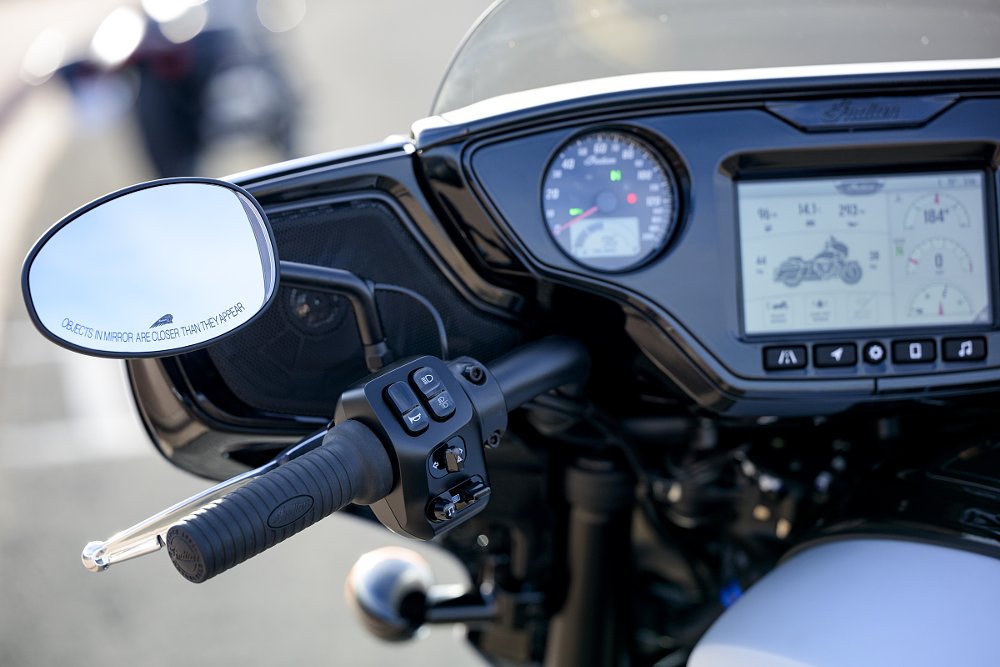
That same sensor enables tailgate monitoring and rear-collision warnings. The monitoring function illuminates a yellowish strip on the main display, telling you someone is close to your rear fender. I found the stock settings to be too conservative and turned them down so they'd be less sensitive. The rear-collision warning uses that sensor to note a vehicle coming up fast from the rear and flashes the running lights on the trailing edge of the saddlebags as a warning. Presumably hoping to get the driver to look up from the phone and apply the brakes. Try as I might, I couldn't find the right closure rate to set off another Chieftain's warning. (Sorry, Kevin Duke, didn't mean to startle you!)
Indian makes the Chieftain and Challenger models in base spec with a limited number of colors, starting at $26,499. You can add an upgraded PowerBand audio system to the upper trims, Limited and Darkhorse, you can add the larger 112-cube engine to the Limited and Darkhorse versions, or you can add both. A top-spec Limited model is $31,749 with the Darkhorse equivalent running $32,749. Only the 112-inch engines have the Rider Assist features.
So we come back to the beginning. Indian seems to be accelerating its use of the PowerPlus platform, and that makes sense. More modern combustion chambers and liquid cooling are nearly a requirement for meeting today's worldwide emissions standards without giving up too much performance. Already the PowerPlus has proven to be successful in competition — winning three King of the Baggers titles — and no doubt has some development headroom baked in.
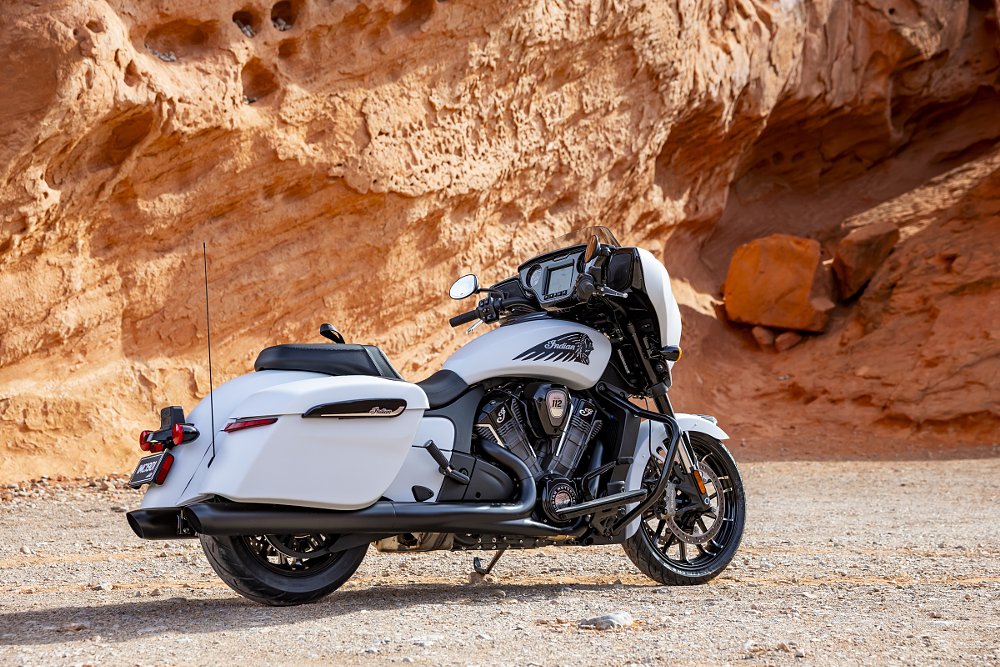
If the sentiment of the collected journalists is any indication, there's significant adoration for the appearance of the Thunderstroke engine. But the PowerPlus is undeniably a better engine that makes the Chieftain and related Challenger/Pursuit motorcycles better machines. Indian has broken away from the "you have to build it this way because that's how we've always done it" paradigm. And is better off for it.
.
| 2025 Indian Chieftain PowerPlus Limited | |
|---|---|
| Price (MSRP) | $30,499 |
| Engine | 1,834 cc, liquid-cooled, eight-valve, V-twin |
|
Transmission, final drive |
Six-speed, belt |
| Claimed horsepower | 126 |
| Claimed torque | 133 foot-pounds @ 3,600 rpm |
| Frame | Cast aluminum |
| Front suspension | 43 mm inverted fork; 5.1 inches of travel |
| Rear suspension | Monoshock, adjustable for spring preload; 4.5 inches of travel |
| Front brake | Dual Brembo four-piston calipers, 320 mm discs with ABS |
| Rear brake | Brembo two-piston caliper, 298 mm disc with ABS |
| Rake, trail | 25.0 degrees, 5.9 inches |
| Wheelbase | 65.7 inches (1,668 mm) |
| Seat height | 26.5 inches (672 mm) |
| Fuel capacity | 6.0 gallons |
| Tires | Metzeler Cruisetec 130/60B19 front, 180/60R16 rear |
| Claimed weight | 808 pounds (as shipped) |
| Available | Now |
| Warranty | 24 months |
| More info | indianmotorcycle.com |














